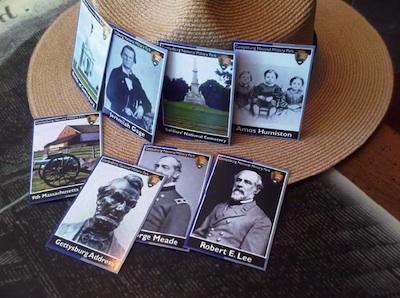People have been collecting stuff forever. When adults visit national parks, they can collect passport stamps or pamphlets. Children earn Junior Ranger badges, though getting one takes a lot more effort and time than a passport stamp.
But there's something else out there to collect, too, and it looks a lot like baseball trading cards. Only these are more educational. Since 2011, select national parks have been giving out trading cards to young visitors. The program, launched at Richmond National Battlefield Park in Virginia, was designed to commemorate the 150th anniversary of the Civil War and to encourage families to visit multiple national parks.

There are baseball trading cards, and there are National Park Trading Cards/NPS
'The program has grown,' says Mike Litterst, a public affairs specialist for the National Park Service who came up with the idea.
The first series of cards debuted in 2011 for the start of the 150th anniversary of the Civil War. The next year, new cards came in as the program expanded beyond the Park Service's Northeast and National Capital Regions.
Now, with 2014 marking the 50th anniversary of the Civil Rights Act of 1964, the trading card program has broadened its theme to Civil War to Civil Rights.
The complete list of cards is on the web. You actually can collect them without leaving home, as you can download individual cards from a Flickr website, but it's more fun to pick them up in the parks. There are now 87 participating parks in 32 states, with a total of 550 cards available.
To earn a card at a park, children can ask a question, engage in conversation with a ranger, or attend a park program. Rangers may have cards in their pocket and hand them out after a discussion. It varies from park to park.
The beauty of this program is that a park can design and give out about as many cards as it wants. Harpers Ferry National Historical Park has 14 cards, ranging from one on abolitionist John Brown to topics on Feeding an Army and Seeking Freedom and Protection. And just like baseball cards, the backs of national park cards have facts about the person or event. Much of that information might be lost on a large park website or on one of many placards throughout the park.
With the potential of 550 cards and maybe some duplicates for trading, how can kids keep the cards so that they don't just become clutter in their rooms? Eastern National sells special clear plastic boxes for 50 cards ($1.99) or 100 cards ($2.99). Or you can buy plastic inserts with pockets for a large ring binder.
Once I saw the list, I wanted to see how certain parks fit in the Civil War to Civil Rights theme. Almost any park in the Northeast or Southeast has a Civil War connection. Civil War battlefields such as Gettysburg National Military Park or Shiloh National Military Park obviously belong in this program. Perhaps not so obvious are the cards from the Brown vs. Board of Education decision and Harry S Truman (Harry S Truman National Historic Site), though each played a major role in the African-American Civil Rights struggle.
Manzanar National Historic Site in California also has a card, as this site remembers the World War II internment of Japanese-Americans in military-style camps. There also are cards that memorialize the lives of five notable internees, including Ralph Lazo, a Mexican/Irish-American teenager who decided to live in Manzanar to stay with his Japanese friends.
Other parks offering trading cards had me scurrying to the individual park website for an explanation because I couldn't see an obvious connection to the theme. The Hot Springs National Park set includes depictions of African-American bathhouse workers; they were the main staff for the bathhouses but couldn't use the facility themselves. The federal government even offered free baths for the poor, a practice that lasted until 1957. The Wright Brothers National Memorial cards include Bessie Coleman, the first female African-American pilot.
I also noticed parks with Civil War and Civil Rights themes without trading cards. Little Rock Central High School National Historic Site is not on the list. Nine African-American students attempted to study at the formerly all-white Central High School after the 1954 Brown v. Board of Education decision.
The Smoky and the Blue Ridge Mountains played a prominent part during the Civil War. Yet, neither Great Smoky Mountains National Park nor Shenandoah National Park have created trading cards. Both parks have active Junior Ranger programs for several age groups. The parks may have had to make some choices, given staffing and financial constraints. Also absent from the collection are general topic trading cards for any of the large Western landscape parks, such as Yellowstone, Yosemite, or Grand Canyon.
Stamps, coins, and even baseball card collections can now be worth a fortune. eBay now sells trading cards. Will they be worth anything in the future?
Engaging and encouraging the younger generation to visit national parks is always a good thing. To get most cards, a family has to search out historic sites, national monuments, recreation areas, and cemeteries. That should be encouraged as well. Maybe they should give out trading cards to adults.

 Support Essential Coverage of Essential Places
Support Essential Coverage of Essential Places







Comments
Looks like a fun way to help stir the interest of kids (and adults) in some of the details about each park - and maybe even learn a little history in the process.
Hi Kurt,
Nice addition. Please include Apostle Islands on your list of Junior Ranger links: https://www.nps.gov/apis/learn/kidsyouth/index.htm